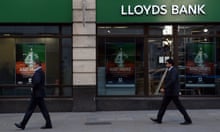UK house prices will continue to slide this year and in 2024 and will not start to recover until 2025, Lloyds Banking Group has forecast.
The lender, which owns Halifax and is Britain’s largest mortgage provider, said that by the end of 2023 house prices would have fallen 5% over the course of the year and were likely to decrease by another 2.4% in 2024.
The forecasts, which were released on Wednesday alongside the group’s third-quarter financial results, suggest an 11% decline in property prices from their peak last year, when the market was still being fuelled by a rush for larger homes after the coronavirus pandemic.
Santander is predicting a larger drop in UK house prices for the whole of 2023 of about 7%, followed by a smaller 2% fall in 2024.
Both lenders said the first signs of growth would start to emerge only in 2025, with Lloyds economists predicting a 2.3% increase in house prices that year and Santander expecting a 2% rise.
“The housing market in 2023 has been a little bit softer than we saw in previous years,” Lloyds’ chief financial officer, William Chalmers, said. “Having said that, as you know, there has been an increase generally in the housing market for a number of years to date, and so we’re retracing a part of those steps.”
Meanwhile, Lloyds said its own finances were being squeezed, as it started to pay out higher interest rates to its savers.
It said its net interest margin, which is a key driver of bank income and accounts for the difference between what is charged for mortgages and paid on savings, narrowed from 3.14% to 3.08% in the July to September period. Lloyds blamed that on “expected mortgage and deposit pricing headwinds” and Chalmers said the decline was expected to continue into the following quarter.
Similar trends have weighed on Barclays, which on Tuesday revealed that its net interest margin had dropped, and would fall further over final three months of the year. Barclays’ chief executive, CS Venkatakrishnan, said the bank had been “very disciplined and prudent and passed through interest rates to customers”.
Competition has forced lenders to start reducing costly mortgage rates while paying out more for deposits, as savers increasingly shop around for more lucrative returns.
It follows pressure from regulators and politicians, who this year accused banks of failing to pass on interest rate rises to their savings customers at the same speed they were increasing charges for borrowers.
Lloyds still managed to report a rise in pre-tax profits to £1.9bn for the three months to September, up from £576m a year earlier. However, that figure has been restated to align with new accounting rules.
after newsletter promotion
Its profits were also flattered by a 72% decrease in the amount of money put aside for potential defaults, to £187m. That compares with the £668m put aside during the same period last year, when it frontloaded its cash cushion amid fears of an economic downturn that could hit the UK housing market.
Lloyds said the number of customers falling behind on mortgage payments was “broadly stable” in the third quarter, and that the growth in defaults had also slowed, but was still slightly above pre-pandemic levels.
Santander also said it had seen a “modest increase” in customers falling further behind on mortgage payments, but added that it expected higher-for-longer interest rates to have a “more pronounced impact on households and businesses” in future.
Chalmers said Lloyds was contacting customers to offer debt advice and shift some borrowers on to better rates. “It is a very extensive outreach programme that is adopted proactively by the bank to ensure that customers that need support get it,” he said.
Danni Hewson, head of financial analysis at the investment platform AJ Bell, said it was clear that Lloyds – at least for now – was “managing to keep bad debt under some kind of control”.
She said: “The key question for investors is how long the company can continue to enjoy some sort of benefit from the higher cost of borrowing and if – or when – the strain on household finances becomes so acute the level of loans gone bad starts to balloon.”







